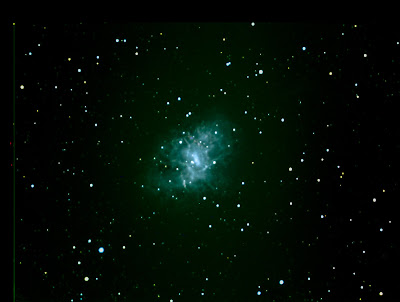M1 - the Crab Nebula - Photo by D. Collins, College View Observatory
The Crab Nebula - M1 in the Messier Catalog has been a popular item for the College View Observatory and Physics Photo of the Week. This color photo required about 3 night sessions spread over 2-3 weeks last month obtaining and stacking many images through the different colored filters in order to create this color photograph.
The Crab Nebula is the expanding remnant of a supermassive stellar explosion of a massive star dying. The large progenitor star suddenly ran out of nuclear fuel and suddenly collapsed as a massive implosion. A stellar implosion doesn't merely cause the star to disappear, but actually causes a massive rebound scattering the outer layers of the star far out into space. This seems counter-intuitive. How can an implosion cause a massive explosion?
This demo was "filmed" in my basement about 3 years ago - not the WWC Physics lab. As can be seen the golf ball bounces highly elastically off the concrete floor with a rebound speed almost 90% of the incoming speed. When the rebounding golf ball collides with the oncoming ping pong ball, conservation of momentum (most momentum is in the golf ball due to the relative masses), the ping pong ball must rebound with much more momentum than it originally possessed.
The same effect occurs in baseball when the less massive pitched baseball meets the swung baseball bat held by the batter to hit a home run. Both the pitched ball and the swung bat center of mass move with about the same speeds - the pitcher's arm and the batter's swing - the ball rebounds with a much higher speed than it originally had - enough to send the batted ball into home run territory.
It is amazing that Newtonian purely mechanical physics can explain an important effect in astrophysics! This amazing nebula is visible in all our back yards in the northern hemisphere merely by looking up (with a telescope!)





Comments
Post a Comment